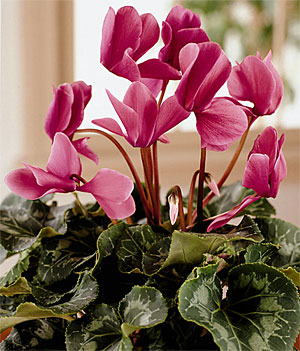






In my tenure at Gardener's Supply, I've been staff horticulturist, retail nursery supervisor, and product information specialist. For a natural teacher, avid gardener and plant geek, my work here is a perfect fit.
Twenty-five years ago, the yard around our old farmhouse was a blank canvas of lawn waiting to be planned and planted. The native shrub and tree borders I planted back then now shelter and feed scores of songbirds. Our fertile soil supports productive vegetable gardens and flowering perennial beds. I've also added fruit and nut trees, blueberries, raspberries and elderberries that feed my family and visiting wildlife. Fussing with chickens and tropical houseplants keep me occupied during the long New England winters. My education is in horticulture and landscape design, and I've authored four gardening books.

Cyclamen are noted for their distinctive flower forms and patterned foliage.
GIVING and receiving flowering plants at the holidays is a time-honored tradition, but one that's fraught with anxiety. Unlike a box of chocolates or a pair of gloves, a living plant requires care to keep it healthy. Holiday houseplants, such as cyclamen, are particularly worrisome for most folks because their flowering cycle and general care are unfamiliar, even to seasoned gardeners.
Florist's cyclamen (Cyclamen persicum) start showing up in grocery stores and garden centers between Thanksgiving and Christmas. Flowers with swept-back petals resemble shooting stars and their heart-shaped leaves are embroidered with intricate, silvery patterns. In the right conditions, the plants will bloom continuously for a couple of months.
Like many other plants in their native eastern Mediterranean climate, cyclamen naturally bloom in the fall, winter, and spring when the weather turns cool and damp. During the hot, dry summers, cyclamen become dormant; their foliage yellows and dies back and plants show no signs of growth. They store energy for the next flowering season in their round tubers.
The key to keeping cyclamen happy and healthy is to replicate their natural environment as closely as possible. They thrive in cool temperatures that drop as low as 40 degrees F. at night and rise into the 60s during the day. Place them close to a bright south-, east-, or west-facing window for maximum sunlight.
Cyclamen are a bit fussy about watering. It's best to let the soil get somewhat dry between waterings, but not to the point of wilting. When the pot feels light or the soil feels dry just below the surface, water it thoroughly and let it drain. Pour out any water left in the saucer so that the soil doesn't stay soggy. Fertilize with regular houseplant fertilizer for flowering plants.
To keep plants blooming, remove flowers as they finish by cutting the stems near the base of the plant. Sometimes the petals will fall off and leave a round seed capsule that resembles a flower bud. Remove these, too. True cyclamen flower buds are long and pointed. Also remove yellow and withered leaves.
In the spring, let the soil dry out and keep the pot in a cool dry place for the summer. The plants will look dead, but as long as the tubers remain hard and plump, they are only resting. Begin watering in the early fall and put it back into a cool, bright window for another season of bloom.
Copyright © www.100flowers.win Botanic Garden All Rights Reserved